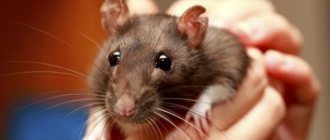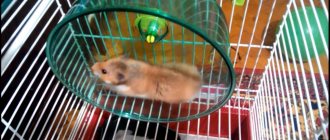- home
- General information
01/25/2019 Sometimes the owner may notice that his hamster squeaks.
The volume and reasons for the squeak vary and depend on the character and breed of the hamster. For example, sounds can be heard extremely rarely from a Syrian hamster, while Djungarians are more temperamental. Caring owners are disturbed by squeaking, snorting and other unusual sounds. Hamsters are usually calm, quiet and unpretentious, and squeaking may indicate discomfort. First of all, you need to find out why the hamster squeaks. There may be several reasons.
Causes
- Marriage games.
When a male hamster courts a female, he sings a song to her. The most gallant individuals perform a serenade for the female before starting mating.
- Good mood.
There is no need to worry prematurely. Quiet squeaking can mean joy from a pleasant meal or meeting with the owner. If your hamster is cheerful and energetic, but starts squeaking when he sees you, know that this is how he says hello!
- Stress.
The hamster may become agitated, for example, when moving. New surroundings and smells frighten the fluffy, and he may squeal. It usually takes a rodent about a week to get comfortable in a new space. During these days, it is recommended not to disturb the hamster, not to squeeze it, not to pick it up. Over time, the pet will adapt and stop squeaking.
- Defense of the territory.
The cute hamster becomes aggressive when it comes to protecting his territory from any other rodents, including his own brothers. If the owner carelessly places two hamsters in the same cage, a fight will inevitably occur. Before a fight, the hamster makes loud sounds similar to squeaking and hissing, as well as crackling and chirping to scare the enemy.
- Need for help.
If your hamster squeaks when it hasn't done so before, check to see if it has food and water. Perhaps he is tormented by hunger or thirst. An animal may also vocalize if it is hot or its cage is dirty.
Oddly enough, some are sure that hamsters do not drink water, but get all the necessary moisture from juicy food. In fact, hamsters, excluding newborns, need water. You need to place a drinking bowl in the cage where there will always be fresh water. It is necessary to train your pet to use it.
- Dreams.
When a hamster squeaks and twitches in his sleep, he is simply dreaming. He can twitch his limbs, make faces and make sounds.
- Bad feeling.
Illness is a serious reason why a small rodent may squeak. Behavior can tell about it: lethargy, loss of appetite, decreased activity, drowsiness. Appearance also says a lot about the health of the animal. He stops cleaning the fur, which makes it look sloppy.
The first thing you need to do is examine your pet: examine its paws, teeth, and skin. Both squeaking and loud screams can indicate discomfort. For example, a squeak after a fall indicates injury. After all, hamsters do not know how to fall and jump correctly, like cats. Therefore, falling from a height, they often receive serious damage.
After being bitten by a subcutaneous tick, the hamster experiences such acute itching that it screams, squeals, gets angry and nervous. If it is not clear why your pet is squeaking, and there are skin problems, demodicosis should be suspected.
Hamsters may experience discomfort due to poor diet. Sometimes they squeak for this reason. In this case, it is worth reviewing your pet’s diet.
How to decipher sound signals
Caring owners will not deliberately tease the animal in order to hear the hamster squeak. The added stress shortens a hamster's already short life. But it's helpful to have an idea of what beeps might mean.
Djungarians make a faint squeak as a greeting. Little hamsters are happy to meet their owner and try to attract his attention. But the reason may be more mundane: the pet has run out of food and is asking for a refill on the feeder.
Interesting! Males use squeaks to attract the attention of females. The hamster squeaks love melodies to his beloved before mating.
Pets sometimes make strange squeaking noises when they sleep. During an exciting dream, the hamster may move its legs. However, constant squeaking at night indicates pain, so you will need to consult a veterinarian.
Learning how to care for a hamster
When getting a pet, you need to find out as much as possible about its habits and the peculiarities of caring for it. Here are some tips:
- In new conditions, the animal may initially experience stress, so it should not be disturbed.
- When changing bedding, leave a piece for the animal to recognize its smell.
- Periodically do a general cleaning of the cage.
- Do not put several individuals in one cage. Each of them should have their own territory.
- Study the dietary features of hamsters of this breed.
If a Djungarian hamster squeaks and at the same time gnaws the bars of the cage, it means that the owner is not caring for him correctly.
How many times a day to feed
Khomkis love to eat and almost never refuse a treat. But don't get carried away with excessive feeding. This is fraught with obesity and other problems associated with excess weight.
Video: feeding the Djungarian hamster It is recommended to feed the animals no more than twice a day. Since hamsters are nocturnal, their main meal should be in the evening.
The baby will spend all the energy received from food during wakefulness. In the morning you can give lighter food and in small quantities. It will be ideal if you can feed your pet at the same time. This is very useful for the full functioning of his gastrointestinal tract.
Why does a hamster squeak and how to help a small rodent
If your Djungarian or Syrian hamster squeaks or makes strange sounds, find out the reason and try to eliminate it.
Check the contents of the cage. Add water or food if necessary.
It is better to leave a hamster that has recently been brought into the house alone. After about a week, the animal will adapt, stop crying and begin to settle down.
If a dwarf is screaming with rage and clearly wants to pounce and bite, there is no need to bother him - this will make him even more angry. Hamsters are scary when angry. In this state, they scream loudly and even rush at people. Therefore, when you hear a hamster scream, it is better to just leave him behind for a while.
If a hamster squeaks at night, in his sleep, there is no need to wake him up and pick him up, this will only scare the animal. Let him sleep on.
The pitiful crying and cries of pain cannot be ignored. An early visit to the veterinarian is necessary. If a pet cries and squeaks in pain, it means it is terrible, because these animals can remain silent, even if they break a leg. The most common cause of pain is colic. They are accompanied by rumbling and enlargement of the abdomen. You need to remove foods that cause fermentation (for example, cabbage) from your diet. If the intestines become severely bloated, the animal may die.
Health problems
Uncomfortable living conditions
Sometimes a squeak means that the hamster is screaming for help. There is no drinking water or food in the cage, it is too hot - all this provokes the pet to declare itself. When thinking about why a lonely Syrian hamster squeaks, check its conditions of detention.
Respiratory diseases
If your pet constantly makes strange sounds - sniffles, whistles, snorts, this indicates difficulty breathing. A rodent can have either a common cold or pneumonia. You should contact your veterinarian.
Strong pain
If a hamster cries in pain, it means it is beyond the pale. A rodent can silently endure even a broken leg. The most common cause of suffering is colic. If the stomach growls and increases in size, and the hamster is worried and whines pitifully, the cause is bloating. Analyze the diet: there are foods that cause fermentation (cabbage).
With strong gas formation, the animal may die.
Discomfort and itching
When infected by a subcutaneous mite, the itching is so severe that the animal squeals in pain and becomes nervous and aggressive. If it is not clear why the Djungarian hamster squeaks and at the same time there are skin problems, you should check your pet for demodicosis.
Decoding other sounds
Sometimes hamsters snort. If the sounds are short and repetitive, it means that dust or small particles of food have entered the animal’s nose. Usually he quickly manages to get rid of them.
But if the hamster began to hiss or sniffle, then this is a cause for concern - he could have caught a cold from dampness or a draft. If your pet does not stop sniffling and choking, you should urgently take him to the doctor.
Sometimes you can notice that the hamster is crying. Then the owner should analyze his behavior: he probably disturbed the animal at the wrong time, or upset him in some way. If you continue to pester, crying may give way to angry screams.
Baby rodents often cry, frightened by an unusual environment. But if no one has offended the hamster, and he makes plaintive, drawn-out sounds, then something definitely hurts him. Go to the vet immediately.
Please note: hamsters cry without tears. If tears are visible in the rodent's eyes or face, it most likely has a respiratory infection.
Excessive attention from owners
Special attention, overprotection will harm not only human relationships, but can also cause cannibalism in female hamsters. Since this rodent is a solitary animal, and after the birth of the cubs the female needs a secluded and calm environment even more, excessive care for these animals will only harm. Do not pick up the hamster and go into the cage less often. Let your family see less of you.
Alien smells repel the hamster's mother. Sensing someone else's scent, he does not identify the puppies as his own creatures and, as a result, abandons them and destroys them. Do not touch the hamster family for a week or two after the babies are born!
You need to prepare in advance for the new offspring of furry rodents. If you find any hamster accessories while cleaning the cage, do not touch them. This is a strategic supply of food, which unpleasantly traumatizes the animal’s psyche if it is lost, even to the point of irregular decline in a pregnant female. Only spoiled food should be thrown away to avoid the growth of putrefactive bacteria, unpleasant odors and poisoning.
For self-organization of the nest, it is recommended to put several paper napkins. Your task is to fill the bowl with clean drinking water and put the food in the feeder on time. This is the only thing the rodent needs from its owner at this time. Nature will do the rest.
Hamster tongue
When a hamster grooms its body, starting with its back legs, front legs and fur, it means it feels safe and happy. When a hamster yawns and stretches, it means that he feels peaceful.
The hamster stands tall on its hind legs, ears pricked up
This means that he is listening to something that has captured his attention.
Dwarf hamsters have scent glands that are located in the middle of the body, on the stomach. Syrian hamsters have scent glands on their sides, that is, on their thighs. Hamsters often rub against objects, leaving behind their scent. Scent glands are used to mark their territory.
When a hamster squeaks, it means that he is afraid or excited. This usually happens in the first days of being in a new environment. This behavior is normal and stops once the hamster is tamed. Dwarf hamsters squeak when playing, trying to gain dominance, or when they are actually fighting.
This sound means that the hamster is irritated and wants to be left alone. It may also be a warning of an upcoming bite.
Hissing is the loudest sound hamsters make. Basically, this occurs when the body is bent, the mouth is wide open, teeth are visible, and the front legs are raised. This means that the hamster is very upset and scared.
Hamster bites cage bars
? This means that he wants to get your attention. This usually happens in the evening or at night. To stop your hamster from biting the bars of the cage, let him out of the cage to run around. Keep an eye on your hamster to ensure he doesn't get injured. Give him something to chew on. If you place toilet paper or an empty roll of toilet paper between the bars of a cage that your hamster is chewing on, it will play and chew on the toilet paper rather than the bars. It takes time for a hamster to become tame. If your hamster nibbles you, it means he wants to get back into his cage.
Treatment
First aid
Change of filler and heat. The room temperature is maintained at about 24 C, but the air should not be dry. Lots of white paper towels are placed in the cage: this is both material for a warm nest and a hypoallergenic environment. If an allergy is suspected, corn filler is also recommended.
To increase immunity, add liquid vitamins for rodents and ascorbic acid to the water, and drink an echinacea decoction. They also give dry nettle and coltsfoot.
The eyes and nose are cleaned of secretions with a damp cotton pad to make it easier for the animal to breathe. Sometimes a hamster sniffles a lot due to the fact that the nostrils are clogged with dried secretions.
Local treatment
For ordinary rhinitis, local treatments are prescribed: the antiviral drug Roncoleukin 50,000 units, 1 drop 2 times a day and Tsipromed (drops with antibiotic) in the same dosage. The Syrian hamster is larger than the Djungarian hamster, but it is equally difficult for both of them to put drops into the nose: during the procedure, the animal constantly twitches and spins. You can simply place a drop of the medicine on the nose and wait for your pet to inhale the liquid. Then he snorts himself.
Systemic treatment
If you suspect a serious infection, you should consult a doctor . But in the absence of a rodent specialist, if a hamster sneezes, every experienced hamster breeder knows what to do at home. Pneumonia is treated with antibiotics. It is not advisable to drink them inside; it can be difficult for an animal with a respiratory infection to swallow. Subcutaneous injections are given with the drug “Baytril 2.5%”. Dose - 0.4 ml (10 mg) per 1 kg of weight. If the hamster weighs 50 g, its dose is 0.02 ml. The drug is administered once a day, in severe cases - 2 times a day, 7-14 days.











